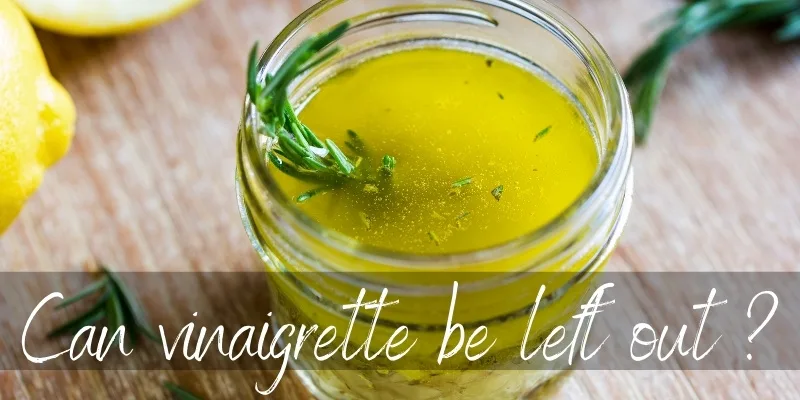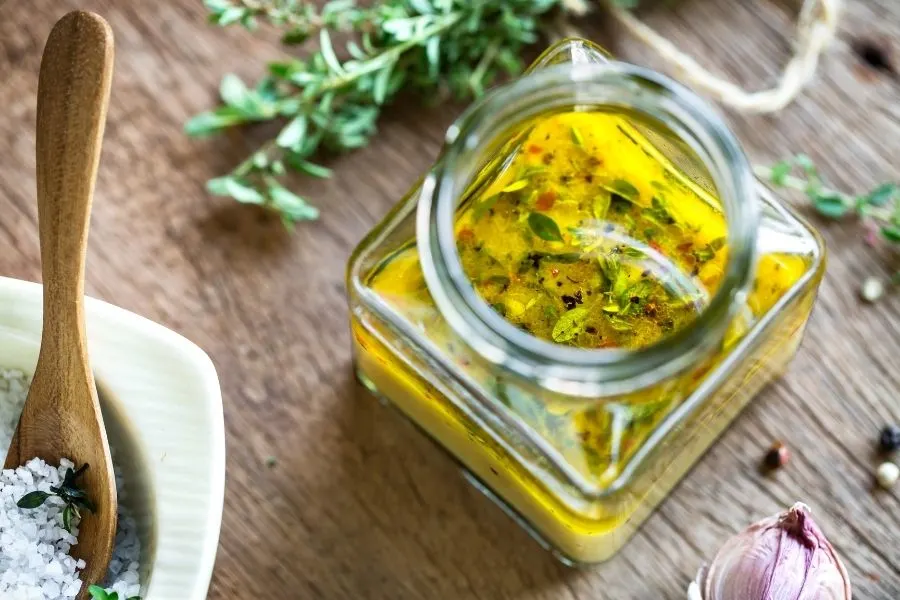Vinaigrettes are definitely a culinary art. How much oil, how much vinegar, what seasoning, and how much per salad is definitely up to the chef. One thing’s certain, vinaigrettes are simpler yet better than most salad dressings out there. Especially if the vinaigrette is home-made, just the way you like it.
You can easily find bottled vinaigrette in stores, but it’s a far cry from the real deal. So today we’re dedicating a post to vinaigrette, and the most common questions about it, plus a few tips on how to make it better. Let’s start !

Can vinaigrette be left out ?
Yes, you can leave vinaigrette on the counter overnight, as long as it’s in an airtight container and away from heat and direct sunlight. The high acidity of the vinegar will ensure no bacteria can develop until morning, so you can safely use it the next day.
However we recommend keeping any vinaigrette in the fridge, to preserve its shelf life. Keeping vinaigrette on the counter for several days in a row will eventually lead to an off taste.
Does vinaigrette go bad ?
Yes, vinaigrette can go bad, especially if left on the counter for several days. In the fridge vinaigrette can last for up to 2 weeks (home-made), while on the counter it shouldn’t be kept for more than 48 hours.
An unopened bottle of store-bought vinaigrette is usually good for about a year, but it should still be stored in a cool, dark, dry place.
Why is vinaigrette a temporary emulsion ?
Vinaigrette is a temporary emulsion because it has no emulsifier added, to stabilize the emulsion. The oil and the vinegar do not mix naturally, so they will only briefly stay together if vigorously shaken or mixed together. The vinegar will separate from the oil and they will eventually form two different layers of liquid.
Read also: Mayonnaise Substitute
Mayonnaise, for example, is a permanent, stable emulsion. This is because it has an emulsifier added, in the form of a raw egg yolk. It does not need to be mixed or shaken in order to resume its emulsified state.
But a bottle of vinaigrette does. This is why you always need to mix this salad dressing in a small jar or bottle, shaking vigorously.
Why is my vinaigrette bitter ?
Vinaigrette can end up bitter because of olive oil that is too bitter, or because of a bad vinegar. In the problem is the olive oil, it’s likely made form green olives. These are the very green ones, often labeled as virgin or extra virgin olive oil. They still retain some oleuropein, which is the bitter compound that makes raw olives inedible.
In this case try and go for a golden-hued olive oil, as that is made from ripe, mature olives with much less oleuropein. Or, buy refined olive oil or simply use a completely different oil.
If it’s the vinegar, it could be a very poor choice of vinegar, or simply too much vinegar. Try adding less vinegar, you need just one part vinegar for three parts oil. And try going for a fruity vinegar like honey-apple.
Tips on improving your vinaigrette
If your vinaigrette often end up an unappetizig, sour mess there are ways to make it much better, and may of these are easy. The key here is to remember to not use too much vinegar, and to take into account whether you’ll have another liquid in there – lie tomato juice. But let’s take a closer look.
Always use a 1:3 vinegar to oil ratio
The vinegar to oil ratio is imprinted in most people’s minds by now. If you don’t already know it, you’ll never forget it. It’s one part vinegar to three parts oil. It could be vinegar, lemon juice, tomato juice, what have you. As long as it’s acidic, it’s just one part and the rest is oil.
Keep in mind that if you’re adding something like mustard you can get more acidity than you bargained for, so only add a little at a time.
Swap vinegar for lemon juice
Vinegar is the go-to option for vinaigrette. It’s in the name, true, but you can always use something else. for example lemon juice brings a fresh, lighter flavor than any vinegar on this earth. If you’re having any sort of seafood in that salad then it’s definitely something to swap.
Or, you can do half lemon juice, half another acid like tomato juice or balsamic vinegar.
Add sugar, honey, or maple syrup
Adding a dash of something sweet can immediately make a vinaigrette that much better. Don’t sweeten this completely ! Just add a bit, less than a teaspoon. It could be sugar, honey, or maple syrup, or anything else you like to use as a sweetener.
But once you’ve added just a little, you’ll remember to do so every time.
Add fresh herbs instead of dried
If you’re not adding herbs to your salad dressings, that’s understandable. Most people don’t but they’re also missing out. A salad is made that much better if it has just a bit of fat (from oil) and extra flavor (from herbs). Whichever herbs you use is completely up to your tastes, but we recommend using fresh herbs whenever available.

There’s just something about the green, fresh flavor of kitchen herbs that makes any meal that much better. For example fresh basil versus dried. A world of a difference ! If you don’t feel like going out to pick some basil, why not get a small plant and keep it in the kitchen ?
Most herbs grow year-round and you can easily snip of however much (or little) you need.
Add mustard for a permanent emulsion
If you want to keep your vinaigrette stable, you will need to add some sort of emulsifier. The easiest to find, or use, are raw egg yolk and mustard. We recommend using mustard for vinaigrette, since it’s blends very well with the flavor profile.
Wondering why mustard, of al things ? Well it turns out there’s something in the mucilage that forms around mustard seeds that stabilizes emulsions.

